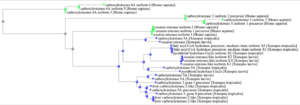XB-FEAT-29081898
ces2.7
This is the community wiki page for the gene ces2.7 please feel free to add any information that is relevant to this gene that is not already captured elsewhere in Xenbase.
nomenclature changes
18SEPT
The Xenopus ces genes appear to be tandem duplicates, that fall within a single clade which is most closely related to the Human CES2 genes, not the CES3 genes as previously thought. Applying Xenopus nomenclature, we have renamed all CES2 orthologs, with X. tropicalis ces2.1-ces2.8, from left to right, and X. laevis genes ces2.1.L-ces2.5.L from left to right. There are no genes on the X. laevis S subgenome.
Therefore the X. tropcialis gene has changed its gene symbol and gene name from LOC100493819, fatty acyl-CoA hydrolase precursor, medium chain, to ces2.7, carboxylesterase 2 gene 7 following phylogenetic and synteny analysis and by applying Xenopus nomenclature rules to this gene expansion on chromosome 4.
We will/have removed the synonym CES5A where possible, as this is misleading, ie: these genes are not ortholgous as CES5A is mammal specific gene - no frog bird or or reptile genes should be called CES5A. See orthology and synteny analysis below.
protein alignment and phylogenetic analysis
18SEPT2023
An alignment and cladogram of all isoforms of the Xenopus ces# proteins was run against all isoforms of the 3 Human CES genes (CES2 CES3 and CES4A, which are all adjacent to each other on CHR6). The results strongly support the hypothesis that the Xenopus clade most closely related to the human CES2 gene, not CES3 (or CES4A) as previously thought.
All Xenopus genes cluster with each other, and not any of the human genes.
proteins accession used in this analysis: NP_001120019.1 XP_004913616.1 NP_001265277.1 NP_001072187.1 XP_031756663.1 XP_031756661.1 XP_002935836.3 XP_002943465.3 XP_018113499.1 XP_018113497.1 XP_018112562.1 XP_041446147.1 XP_041446153.1 NP_001352334.1 NP_001172105.1 NP_001177130.1 XP_031756662.1 XP_004913614.2 XP_041446148.1 NP_001352335.1 NP_001172106.1 NP_001177131.1 XP_031756660.1 XP_041446149.1 NP_001352336.1 NP_079198.2 NP_001305435.1

Furthermore, note that human CES5A does not have any amphibian orthologs recognized by NCBI, and it does not share a conserved syntenic position(s) with Xenopus. Furthermore EBI's EggNoggv5.0 gene/protein family/homology tree for CES5A indicates that CES5A is a mammal specific gene, thus frog genes should NOT be called ces5A , although several were annotated as ces5a in the v10 genome annotations.
Human CES5A (Gene ID: 221223 ) and mouse Ces5a (geneId: 67935) have been removed from all of these Xenopus ces2gene pages.